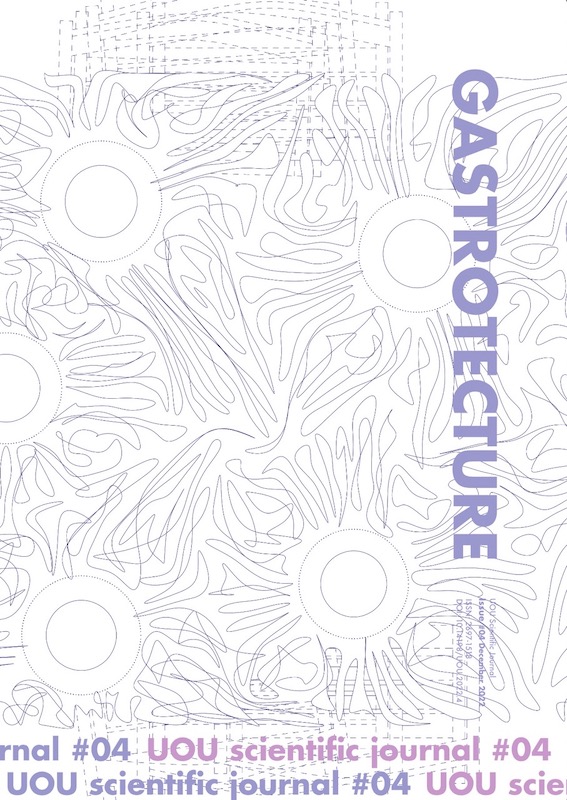Junk Food
Abstract
The construction of a shelter and to eat are part of the reduced group of basic needs, those that we cannot do without but that willingly accept improvements that oscillate between the cultural, the social, the aesthetic or the political. The result of these updates will give rise to architecture and gastronomy respectively.
One of the most fascinating tandems between gastronomy and architecture, due to its literalness and immediacy, was provided by the radical group Street Farmer with the Eco-House designed and built by Grahame Caine in London in 1972. The house, understood as an active laboratory during the more than two years it lived, materialized the anarcho-ecological ideas of a group of architects who trusted in the reformist and emancipatory capacity of an architecture detached from the dominant technophile circles at the time in the Architectural Association.
La construcción del refugio y comer forman parte del reducido grupo de necesidades básicas, aquellas de las que no podemos prescindir pero que aceptan con gusto mejoras que oscilan entre lo cultural, lo social, lo estético o lo político. El resultado de estas actualizaciones dará lugar a la arquitectura y la gastronomía respectivamente.
Uno de los tándems más fascinantes entre gastronomía y arquitectura, por su literalidad e inmediatez, lo aportó el grupo radical Street Farmer con la Eco-House diseñada y construida por Grahame Caine en Londres en 1972. La casa, entendida como un laboratorio activo durante los más de dos años que "vivió", materializó en la Architectural Association las ideas anarcoecológicas de un grupo de arquitectos que confiaron en la capacidad reformista y emancipadora de una arquitectura desligada de los círculos tecnófilos dominantes del momento.
Downloads
References
- CAINE, Grahame in Street Farm. P141
- CAINE, Grahame. Eco-House. Mother Earth news 20. March 1973. P62
- KALLIPOLITI, Lydia. From Shit to Food. Buildings & Landscapes: Journal of the Vernacular Architecture Forum. Vol. 19, No. 1 (Spring 2012), pp. 87-106.
- Interview with Peter Crump in COLOMINA, Beatriz and BUCKLEY, Craig. Clip, Stamp, Fold. Ed. Actar Publishers. Barcelona. 2010. P253
- KALLIPOLITI, Lydia. From Shit to Food. Buildings & Landscapes: Journal of the Vernacular Architecture Forum. Vol. 19, No. 1 (Spring 2012), pp. 87-106.
- Archigram. Princeton Architectural Press. New York.1999. P110
- LUENGO ANGULO, Miguel. La Arquitectura Radical. Cinco puntos para una redescripción teórica. Editorial Diseño. Buenos Aires. 2021
- Archigram. Princeton Architectural Press. New York.1999. P110
- Archigram. Princeton Architectural Press. New York.1999. P114
- DALLEGRET, François and BANHAM, Reyner, A Home Is Not a House, Art in America, Vol. 2, 1965: 70-79.
- HUNT, Stephen E. The revolutionary urbanism of Street Farm. Ed. Tangent Books. Bristol. 2014. P141
- KALLIPOLITI, Lydia. From Shit to Food. Buildings & Landscapes: Journal of the Vernacular Architecture Forum. Vol. 19, No. 1 (Spring 2012), pp. 87-106
- BOYLE and HARPER, Radical Technology, p171
- KALLIPOLITI, Lydia interview with Caine. 2008 in HUNT, Stephen E. The revolutionary urbanism of Street Farm. Ed. Tangent Books. Bristol. 2014.
Downloads
Published
How to Cite
Issue
Section
License
Copyright (c) 2022 Miguel Luengo Angulo

This work is licensed under a Creative Commons Attribution 4.0 International License.
The authors keep their rights upon their work, although they transfer, in a non-exclusive way, the rights of exploitation (reproduction, publication, distribution, public dissemination and presentation) to the Journal. The authors are, therefore, free to enter additional, separate contracts for the non-exclusive distribution of the version of the work published in the Journal (for instance, by hosting in an institutional repository or publication in a book), provided credit is given that the work was initially published in this journal. The works are published under a Creative Commons Attribution 4.0 (CC BY 4.0) license.












